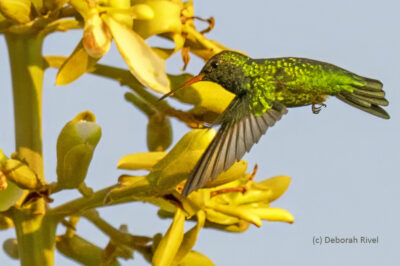
Why are Hummingbirds so aggressive? Life on the edge of survival can create tension and a need to dominate food. But the way you provide food for hummers can make a difference.
Ever wonder why that hummingbird comes to your feeder so frequently, then disappears? Only to return several more times in the hour to feed, but comes charging in whenever an interloper approaches the feeder? Hummingbirds have the fastest heart rate of any bird – some up to 1200 beats per minute. With wings that can beat over 4000 beats per minute. To fuel this teeny, fast-moving machine, they need to feed every 10-15 minutes, and to do this, visit 1000-2000 flowers each day. Traditionally, this high-energy nourishment comes from flower nectar with an insect snack. But, whether hummingbirds get their energy from flowers, sugar water feeders, or other native plants, anything that provides food in their territory is aggressively defended. But this also means they spend more energy than they need to defend what are often limited food sources in a large territory. And here is where you can lend a hand!
If you plant native species of flowering plants which hummingbirds can feed from, this will add to the nectar supply. And by increasing the availability of food, make it possible for each bird to defend a smaller territory. In other words, the birds will have less area to cover and spend less time and energy defending it. But nectar and sugar water alone dont make a balanced diet. Adding other native plants that dont necessarily flower will also provide the tiny insects which are an important source of protein to hummingbirds, and will make your yard or garden a more attractive energy source for these high-energy demanding birds.
Placing feeders in alternate locations out of sight from each other, or setting up multiple feeders to provide an abundance of food, can help reduce quarreling among hummingbirds. While this approach is effective, it does require extra effort to maintain additional feeders. However, in areas with a high hummingbird population, this strategy can significantly lower their stress levels, enhancing both their feeding experience and your enjoyment of watching multiple birds more tolerably share the space.
Some of the most visited flowering plants for hummingbirds according to Audubon are below. Check out the Audubon Native Plant Database to find the species native to your area:
- Beebalm, Wild bergamot, Horsemint, Monarda fistulosa – Native in southwest, Pacific northwest, mountain west, southeast, east and mid-west sections of the U.S.
- Lemon beebalm, Monarda citriodora – Native to California, southwest and southeast sections of the U.S
- Scarlet beebalm, Monarda didyma – Native to the Pacific northwest, east and mid-west sections of the U.S
- Spotted beebalm, Monarda punctata – Native to California, New Mexico, Texas, southeast, east and mid-west sections of the U.S.
- Coral honeysuckle, also known as Trumpet honeysuckle, Lonicera sempervirens – Native to the southeast, east and mid-west sections of the U.S.
- Cardinal flower, Lobelia cardinalis – Native to California, the southwest, southeast, east and mid-west sections of the country
- Scarlet sage, Salvia coccinea – Native to the southeast U.S.\
- Lemmon’s sage, Salvia lemmonii – Native to the southwest U.S.
- Gregg sage, Salvia greggii – Native to Texas
- Pitcher sage/Hummingbird sage, Salvia spathacea – Native to California
These native plant groups can have a variety of species that span the country. You can learn about recommended native plants that attract hummingbirds here.
For more information, check out this Audubon article.